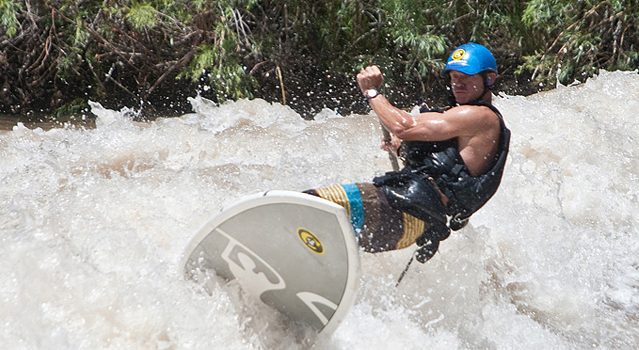For decades, extreme sports athlete and instructor divided his time between all areas of skiing and kayaking. Based out of Aspen, he founded the and has worked as a ski patroller in Aspen/Snowmass for 27 years. In 2004, not content with his wide portfolio of races and first descents, MacArthur was hooked by the emergent sport of stand-up paddling. He went on to develop techniques and gear that have made the sport accessible to everyone, from weekend warriors to competitive athletes. MacArthur has taken a paddleboard on first descents of challenging whitewater from Colorado to Hawaii. He’ll be leading stand-up classes at this coming weekend. When we caught up with Charlie, he was a bit out of breath from pumping up paddleboards for his latest SUP course in Jackson, Wyoming.
The growing interest in stand-up is phenomenal. What’s attracting people to the sport?
Everyone, deep down, has a secret desire to surf. Who doesn’t fantasize about riding a wave? The fact is, SUP is really easy, and it makes the surfing sensation really accessible. You can go out in flatwater; you don’t have to be in great shape; and it’s as easy as standing on a sidewalk because the board’s so stable. The perspective you have on the water is awesome, and it’s a thrill to stand up while you’re paddling.
You got into stand-up long before it hit big.
Earlier than you might think: I first did it after watching an old Hawaiian guy on a paddleboard in 1973. I was 13 and lasted just about 15 minutes. (I was trying to SUP on a longboard with a canoe paddle—pain in the back.) I didn’t try it again until my honeymoon in Fiji in 2003. I was on a tandem board and had a proper-length paddle, which makes a world of difference. I was hooked. I quickly bought a long surfboard—there weren’t really good paddleboards then—and brought it back to Aspen in 2004, where I started paddling rivers.
So ���ϳԹ��� in Aspen takes place on your home turf. Anything in particular you’re looking forward to this weekend?
I’ve been told by the higher-ups that stand-up is going to be the most popular event at ���ϳԹ��� in Aspen this year. I’m psyched to turn people on to the sport. I’ll also be going to the SUP National Championships in Glenwood, Colorado, which I helped start four years ago. Brad Ludden will be in Aspen, whom I’m excited to see—great kayaker.
You’re known for difficult first descents in kayaking and stand-up. How is it different to be the first person down a river on a paddleboard?
Since kayaking is an older sport, most of the first descents have been done. In order to snag a new one, you have to paddle really hard stuff—Class V-plus. If you were going to shoot for a first descent on easier rapids, it would have to be super remote. My first descents for stand-up were relatively easy because I started when the sport was young. You could paddle quite a bit of Class III and IV and know that you were the first person to go down that river on a paddleboard. (Slaughterhouse rapids in Glenwood and Westwater Canyon on the Colorado River in Utah were two big firsts of mine.) There aren’t a lot of people paddling Class IV. These days, being a little older and having a family, I’m not chasing rivers and trying to get first descents as much as when I was younger.
Is it more dangerous—do you swim more than you would in a kayak?
On average, you might swim a little bit more because of the balance factor. As you get better, you reduce the swims. You work your way up to harder whitewater. When things get gnarly, you drop down on the board and extend back up. But a unique feature to stand-up is the joy of swimming. It’s easy to get in the water, and it’s easy to get out and back on your board. When you get to be a good enough kayaker, you no longer swim. I kind of missed it.
When snowboarding came up, there wasn’t a whole lot of respect for it. SUPers face similar discrimination from surfers. Why is that?
You’re competing for limited resources. In snowboarding, it was the slopes. In stand-up, out in the ocean, you’re competing to catch waves. With a stand-up board, it’s easier to catch a wave than on a surfboard. You’ll see people with not a lot of experience, no wave etiquette, getting out into the lineup, catching waves and getting in other people’s way. It quickly gives it a bad name. Stand-up paddlers need to learn to surf first if they’re going to take their place in a lineup.
You started paddling on a surfboard and eventually pioneered the first stand-up river board. What’s it like to figure out a new sport?
So cool. It feels like you’re part artist, part scientist. You’re noticing and trying new things every day: What if I tweak this? Hey, that worked! Wonder if I try this…. You have to let go of judging yourself. Same thing with designing the board.
What do you hope for the future of the sport?
Really, I’d just like to see it stay. It’s had massive growth in popularity over a short period, but that’s going to slow down at some point. I’d like to see people who normally have a kayak and a canoe in their backyard add a stand-up paddleboard to that. It’s an excellent workout. Beyond recreation, I see it as a great cross-trainer for virtually every other sport.
, June 8-10, is a weekend filled with outfitter-led adventure, including mountain and road biking, kayaking, rafting, trail running, fly-fishing, hiking, stand-up river paddling, and rock climbing for all skill levels. The weekend also includes parties, a base camp featuring ���ϳԹ���’s Gear of the Year, a symposium with professional adventure athletes and ���ϳԹ��� personalities.


